Ground cover doesn’t just mean smothering your garden weeds with easy-to-grow shrubs. It can be a beautiful way to create seasonal displays across your whole garden if you get it right.
Prostrate shrubs are an important building block for ground cover planting, but they should be accompanied by generous bulb planting and herbaceous displays that keep weeding to a minimum and afford striking flowers all year round.
Use a mix of natives and non-natives to maximise the flowering season, and provide plenty of nectar for hungry bugs along the way.
More...
What are Ground Cover Plants?

Ground cover plants are anything from low-growing bulbs (crocuses and daffodils) to wide spreading herbaceous plants like salvias, or spreading, prostrate shrubs, like grevilleas or rosemary.
They work beautifully as part of tiered planting arrangements, or by themselves to create distinctions between areas of practical patios and lawns.
Benefits of Planting Ground Cover Plants
Ground cover plants help you fill out empty borders quickly, but they also help the soil. Shrubs and herbaceous ground cover plants, like Heuchera and rosemary retain soil structure, and protect your earth from drying out too much through summer.
Others, like ground cover grevilleas, actually help to aerate the soil, and root through most soil types to allow easier planting for their surrounding beds.
Bulbs play a big part in ground cover too, and even plants that are often seen as problematic like mint and self-seeding wildflower can provide flowers and verdant colour across the year.
The main reason most of us go for ground cover plants, at least at the front of our borders, is as weed suppressants. The thicker the foliage, the more light is blocked, and for self-seeding weeds in particular, it can stop them altogether.
For deep rooted weeds, ground cover presents them with competition, and reduces their spread over time.
Considerations When Choosing Ground Cover Plants
Choosing the right ground cover plants for your garden isn’t just about existing conditions. You can amend soils easily, and with little effort so that you can grow anything you like, but what you can’t change is your climate.
Seasons with relatively little change can be difficult for bulbs to thrive, as they often need a period of cold to trigger flowering.
Similarly, wet winters aren’t great for many prostrate shrubs, which struggle in humid cold conditions, as their foliage is closer to the ground and remains wetter than it should – particularly true of Mediterranean prostrate shrubs, and natives to WA or Australian coasts.
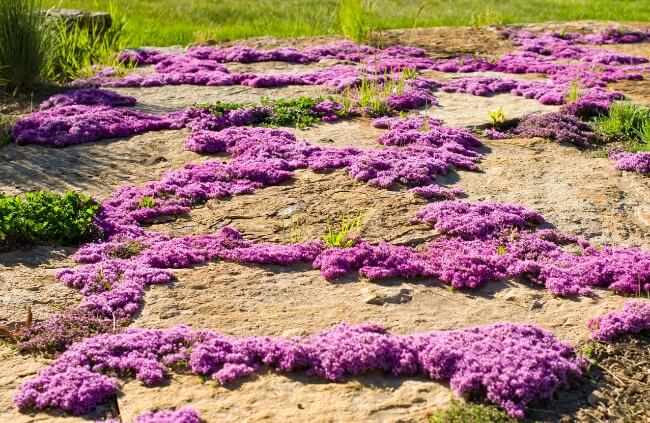
Soil Types
Clay soils are rich in nutrients but will present some drainage challenges. Bulbs will struggle to grow in these conditions, and many herbaceous plants will suffer over winter.
Improve clay soil for ground cover plants by mulching over several years with organic matter, and allowing worms to do the rest. For faster results, dig in gypsum, but be aware that it can cause some nutrient imbalances and make locked phosphorus accessible to plants – not great for many native ground cover plants.
Sandy soils are great for bulbs as they drain well, but should be fed with bulb fertilisers in granular form in late winter to boost flowering. Most ground cover plants do best on sandy soils in general, but will truly thrive with added homemade compost to provide slow release balanced nutrients all year round.
Light Conditions
Ground cover plants all have different light conditions, but that means there will be a plant for every part of your garden. For shade, you can plant gorgeous ground swathes of Hellebores, Hostas, ferns and Bergenia.
In bright conditions, crocus provides spring interest, or in free-draining shade, lavender, catmint and grevilleas make beautiful statements, and add scent in summer.
Reasons for Growing
And finally, before you pick out a plant just because you like the look of it on paper, think about what you want to achieve in your garden. Are you growing ground cover plants as a practical mulch, for a low-maintenance garden, or as a seasonal pop of colour in dramatic, low-budget swathes of jewel-like colour?
Or even for structure? Ground cover might not seem like an architectural grouping of plants, but there’s much to be said of the benefits of lavender hedges for formalising otherwise unkempt patches of garden.
Think too, maybe more creatively, about how you can use ground cover to improve your soil in the short-term for long-term gain.
Potatoes, or pumpkins, for example, might not seem like the most exciting garden plants, but if you have really poor soil, they will help to lock moisture in, and root through the worst of soils, so that next year you’ll have a healthier garden to plant into.
42 Best Ground Cover Plants in Australia
Native Ground Cover Plants
1. Ground cover Grevillea
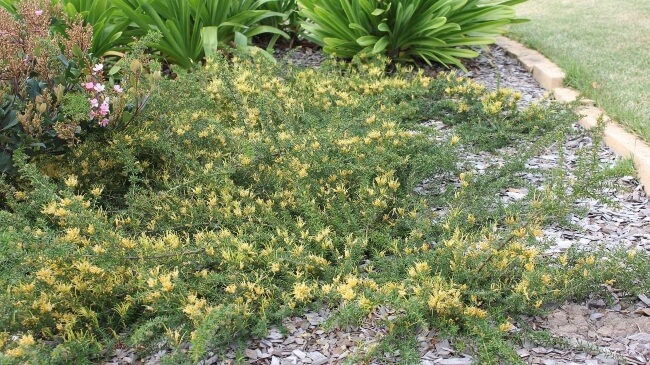
Source: Alpine Nurseries
Some ground cover grevillea will fill out entire borders in a couple of years. Others are slower growing but with more ornamental value.
Like everything in gardening, having a little patience will offer better results, as with the faster growing ground cover grevilleas tend to look better with some preemptive pruning as they establish.
Read more in our guide to ground cover grevilleas.
2. Australian Native Violets

Source: The Gardener
Australian native violets are a fast-spreading herbaceous perennial, which can be used for low-use lawns, or simply to create softer edges to planting beds.
Their dense foliage makes them a wonderful option for planting around vegetable beds as a distraction to slugs, who tend to stick to them as an easy target, before crawling over to other veggies.
For more information on growing these stunning ground cover plants check out our guide to Native Violets.
3. Hardenbergia
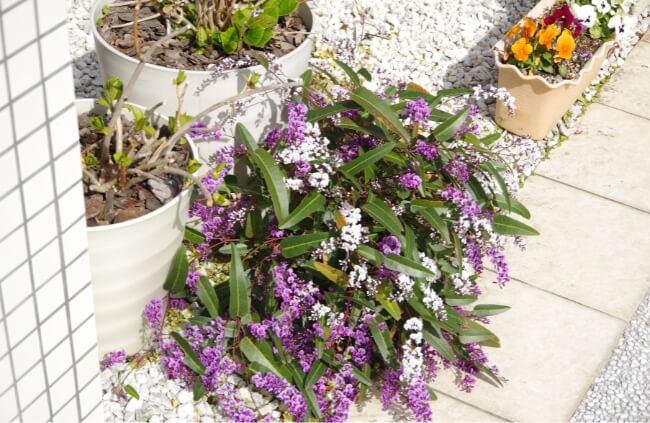
Hardenbergia are mostly tall shrubs or small trees, but a few beautiful cultivars are prostrate types which spread out horizontally and will even rail over walls. Their vibrant, deep-purple flowers make a stunning statement in any garden, and they respond well to pruning so can easily be kept tidy all year round.
Our full guide to growing native Hardenbergia in Australia gives more information on growing conditions.
4. Westringia

Source: Australian Outback Plants
Westringia are (mostly) low growing shrubs, offering permanence unlike some herbaceous and bulb-forming ground cover options. Their evergreen structure varies in colour from species to species, but some of the most popular offer dense silvery foliage topped with pale pink or white flowers.
With tight clipping they can be used as informal topiary balls too, making semi-formal gardening a breeze.
More information on growing Westringia of all types, including ground cover, is available in our Westringia growing guide.
5. Ground cover Banksia
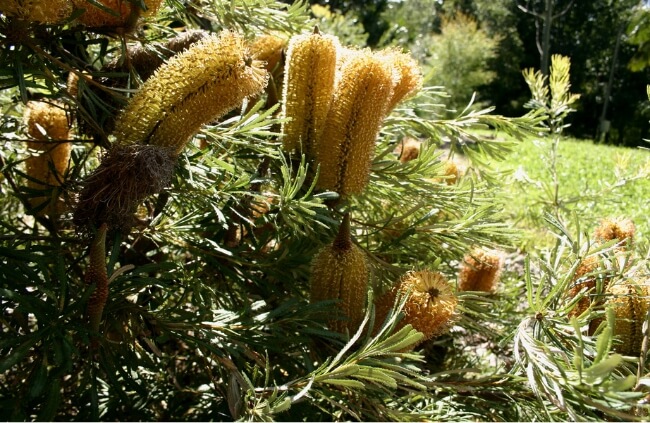
Banksia blechnifolia is the most effective ground cover banksia, with separate foliage and flowers that develop at ground level. It’s distinct from nearly all other banksias, but is not the only cultivar that can be used easily as ground cover in Australia.
For more information on how to grow this wildlife-friendly native ground cover, read our Banksia growers’ guide.
6. Sturt Desert Pea (Swainsona formosa)
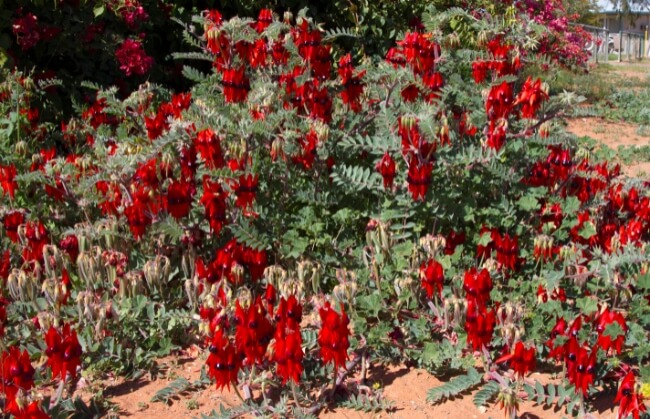
Swainsona formosa, commonly called Sturt’s Desert Pea, is, despite nearly every part of its appearance, a member of the legume family (Fabaceae), most commonly recognised as peas and beans.
Its flowers are strikingly different to anything else in the plant family, with bold, hanging rings of red and black flowers, with pointed petals, held on stems that are low-growing and silvery, with relatively thick round forms.
For gravel gardens, or dry gardens in Australia, this native ground cover is definitely worth considering for ornamental value alone, but it’s also exceptionally useful for summer pollinators.
Our guide to growing Sturt Desert Pea offers more detailed growing instructions.
7. Australian Pigface (Carpobrotus)

Pigface (Carpobrotus) is a succulent genus of ground cover plants, native to various parts of Australia. It copes well with most growing conditions other than very damp, provided it is planted directly into a gritty soil mix so that the roots aren’t directly sat in wet soil.
With a spread of up to 3m, these vibrant flowering succulents are a practical choice of native ground cover for any relatively dry garden.
Read more in our guide to growing Australian Pigface.
8. Warrigal Greens
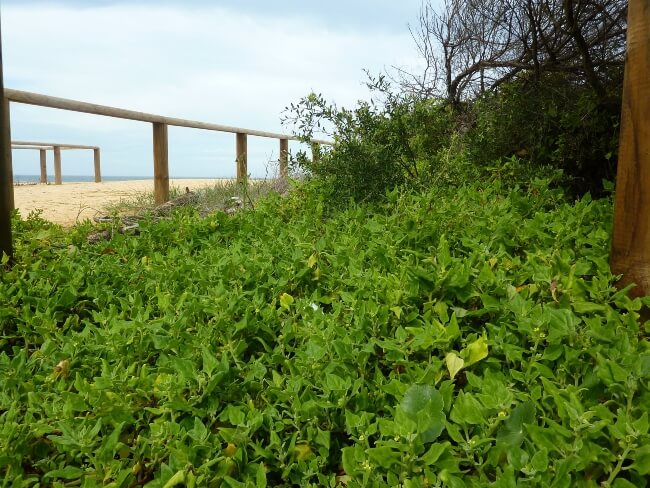
Source: Gardening 4 Kids
Warrigal greens aren’t the most inspiring ground cover choice for your garden, I accept that, but they are an excellent ground cover for veggie plots, and can be grown between rows of other crops for fast crops while helping to keep weeds down on cultivated soil.
They are hungry plants, and personally, I really don’t like the texture, but for any Australian veggie grower, they really do help to reduce your workload through spring and early summer.
Grow warrigal greens to perfection with our warrigal greens growing guide.
9. Wahlenbergia

Source: Bungalook Native Nursery
Wahlenbergia is part of the Campanula family (Campanulaceae), and for all intents and purposes, it looks the same, and acts the same. However, it’s native to Australia and well adapted to our less temperate climates, coping beautifully through hot summers, and dying back neatly over winter.
It’s a reliable ground cover plant that offers lively colours at all stages of growth, and makes a great case for herbaceous ground cover, as opposed to ground cover shrubs.
Learn how to grow Wahlenbergia at home with our full Wahlenbergia grow guide.
10. Kunzea capitata

Source: Australian Plants Society NSW
Kunzea, as a wider species, aren’t a good ground cover choice, but Kunzea capitata, with low-growing, wide-spreading branches, and gorgeous hot-pink flowers is a fantastic low-maintenance ground cover plant offering accessible nectar to native pollinators.
It typically grows into a 1m tall mound when mature, but with dense foliage that effectively keeps light and nutrients from any weeds brave enough to try and develop under its canopy.
Our Kunzea capitata growers’ guide offers more information on growing this beautiful native ground cover plant.
11. Kidney Weed (Dichondra repens)
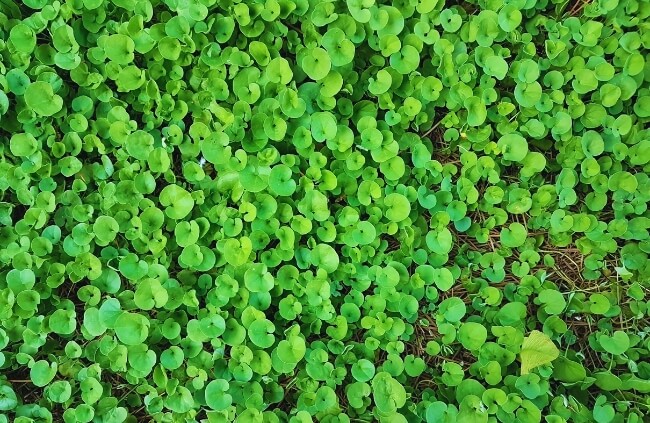
Dichondra repens, also known as kidney weed, is one of the easiest lawn alternatives to grow in Australia, but as its name suggests, it can be invasive and will spread across the garden with ease.
If you’re willing to let it run rife in your garden there are no easier lawn cover or ground cover plants to grow.
The lush green carpet that kidney weed creates is beautiful and tough in equal measure and a wonderful ground cover plant for gardens with full sun or part shade.
For more insights about this vibrant ground cover plant, read our comprehensive kidney weed growing guide.
12. Austral Bugle (Ajuga australis)

Ajuga is such a simple plant to grow in well-drained or moist soils, but if you can offer it a good loamy base, the nutrients will set it in motion as not just a useful ground cover plant, but also one of the loveliest flowering plants in your garden.
Its thick, leathery foliage, paired with gorgeous pink to blue flowers makes for a stunning combination and one that’s as easy to grow as it is tough.
We’ve had Ajuga australis (also known as the Austral Bugle) growing alongside most of our paths for several years, and it gets kicked, run over with wheelbarrows and trodden on every single day. It's not a lawn-cover alternative, but is perfect as a base for border planting and path edging.
13. Native Daisy (Brachyscome multifida)

Source: Australian Native Plants Society
The delicate mauve flowers you’ll see on most seed packets are slightly misleading with native daisies. Brachyscome multifida, to give it its proper name, is more often pale pink or white when in flower, but its frothy foliage extends its charm beyond the flower.
Bees and pollinators adore this native daisy, which works perfectly well in pots and hanging baskets but is at its absolute best railing along the ground and providing ground cover and weed suppression that is dense and airy at the same time.
For more insights about these beautiful ground cover plants, check out our in-depth native daisies growing guide.
14. Prostrate Casuarina (Casuarina glauca)
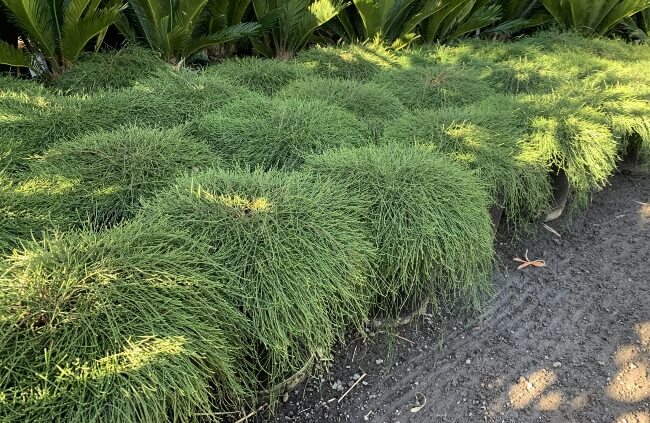
Source: Bamboo South Coast
Most gardeners I know find Casuarina glauca to be slightly on the side of overkill of groundcover but if you’ve got the space for it, the trailing pinnate foliage is utterly unmatched.
It will grow into a dense mound if planted on level ground, but if planted on a slope, or over a wall, the trailing branches are dramatically spreading and create unified and coherent landscapes with ease.
Ground cover plants are typically annuals, and perennial herbaceous plants, but low-growing shrubs like Casuarina glauca are as beautiful, and probably a more practical choice for most gardeners.
C. glauca ‘Cousin It’ is the most popular variety for planting in Australian gardens, thanks to its containable formality.
15. Creeping Boobialla (Myoporum parvifolium)
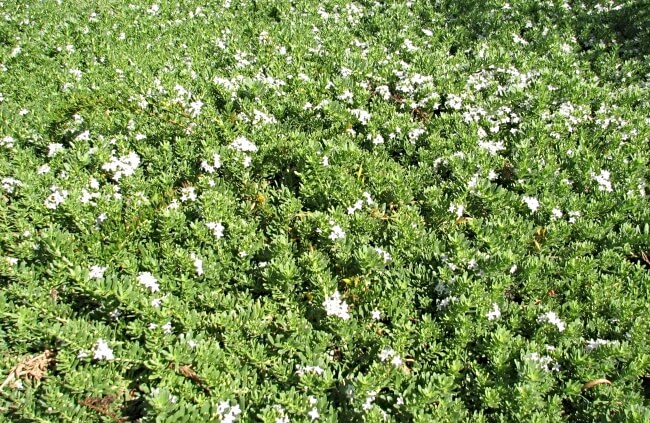
Source: Australian Outback Plants
Myoporum parvifolium, better known as creeping boobialla, is all about the verdancy. Green, green and more green. It does flower, and the resulting flowers are quite lovely up close, but they are far from the main attraction of this dense and well-spread plant, which can easily cover an entire lawn from a few dozen plug plants.
It’s a useful lawn alternative for low-traffic areas, and an even better border ground cover plant, as it has relatively low nutrient needs, so it grows in and around shrubs and herbaceous perennials without restricting other growth significantly.
To discover more about this resilient ground cover plant, explore our guide on growing creeping boobialla.
16. Blue Flax Lily (Dianella caerulea)

Source: PlantMaster
Blue Flax Lily, or Dianella caerulea, is the true gardener’s choice for ground cover. It’s a clever way to pack out a space on a budget and add colour, height and fragrance while also helping to suppress weeds.
Their delicate foliage and ornamental flowers disguise the thuggish nature of their sturdy and hungry rhizomatous roots, which fill out borders quickly and spread easily. That means that weeds struggle to compete, and they’re easy to weed between, with good recovery rates if you do accidentally snap a root section off.
For something a little different, and groundcover with height, it's well worth propagating your own either from root cuttings or seed.
For more insights about this ground cover plant, check out our comprehensive guide for growing Dianella caerulea.
17. Prostrate Callistemon
Callistemon is widely known as the bottlebrush plant. It is one of Australia’s most iconic native shrubs, and it’s definitely better known as a tall shrub than it is for ground cover, but did you know that there are several species of prostrate Callistemon, including the cultivar ‘Candle Glow’, that act as an easy-going, low-maintenance ground cover?
Prostrate Callistemons have all the drama of their upright cousins, but help to cover soil, maintain moisture in the ground through shade, and are ideal for gardens with kids as they can easily take a beating for a stray football.
Delve into our in-depth guide for growing Callistemon for more insights.
18. Salmon Correa (Correa pulchella)
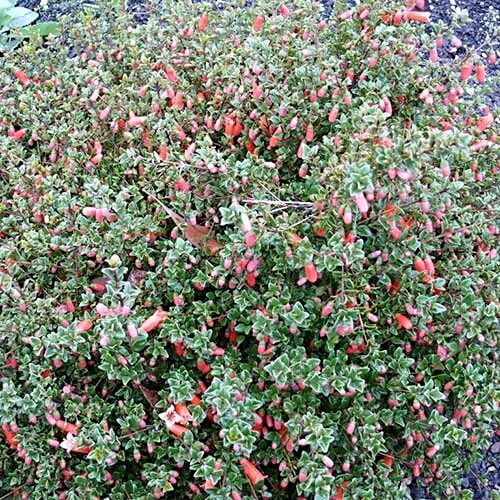
Source: Future Forests
Correa pulchella is a great choice for more experienced gardeners who want a ground cover that does something different. The salmon pink, drooping, bell-shaped flowers are utterly beautiful, and the fine foliage is particularly useful for smaller gardens where you need to play with scale and perspective to enhance your space.
But they are not reliably prostrate. That means that in some gardens, depending on the soil and light levels, they can grow taller, and form a domed shrub, rather than strict ground cover, and do need regular pruning to maintain a reasonable height.
19. Flame Bush (Adenanthos cuneatus)

Source: Gardening With Angus
The flame bush, or coastal jugflower, amongst its many descriptive common names, is an ideal ground-cover choice for coastal gardens, or hot, exposed plots.
The succulent foliage, with dramatic red cupped flowers are a talking point in any garden, but they are also instantly recognisable as native plants.
For a simple solution for exposed gardens, where ground cover is needed to suppress weeds and stabilise loose, sandy or gritty soils, Adenanthos cuneatus is a sensible choice with clear rewards.
Explore our comprehensive Adenanthos cuneatus growing guide to learn more about this unique ground cover plant.
20. Bower vine (Pandorea jasminoides)

With star-jasmine-like flowers and delicately waxy pointed foliage, this trailing climber is a really simple, and incredibly manageable ground-cover plant for most Australian gardens.
Pandorea jasminoides (commonly called the bower vine) is hardy in cold conditions, puts up with rain and wind, and is reasonably drought tolerant too. Its flowers are larger than true jasmine, and more dramatic too, and it won’t suffer if grown along the ground like its namesake either.
When grown near a fence, or shrubs it has a habit of climbing upwards, but it will trail quite happily along the ground to provide fast-spreading and adaptable ground cover.
21. Scaevola
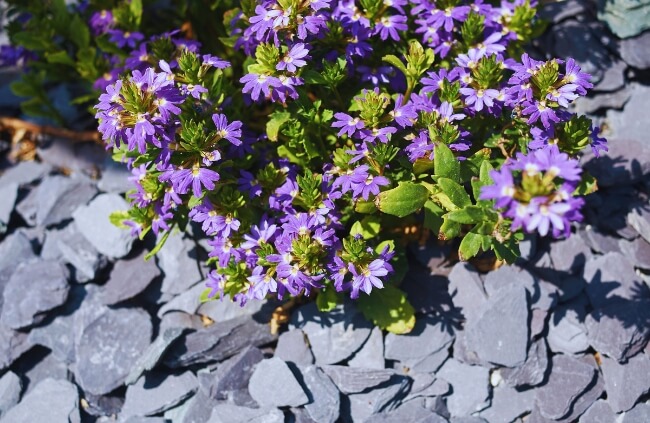
Native to Polynesia and Australia, Scaevola is an unusual native that looks more at home in cottage gardens than amongst tropical shrubs. Its fine, violent-coloured flowers outperform most plants, and when not in flower its finely-toothed foliage offers texture and interest.
It requires excellent drainage, so is usually grown in pots, but if grown in good conditions in the garden it will spread slowly and manageably, providing spectacular colour and practical weed suppression year after year.
22. Hop Goodenia (Goodenia ovata)
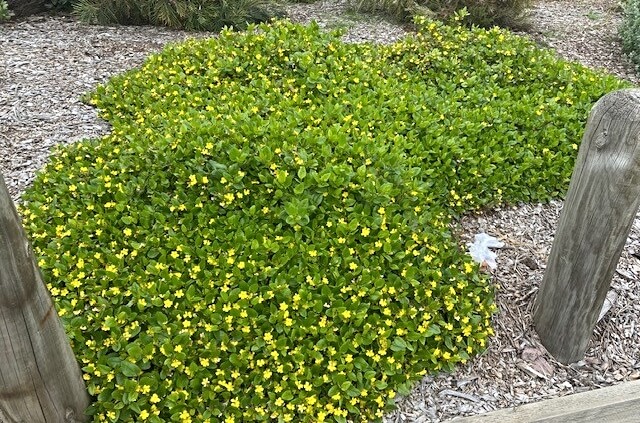
Source: The Garden Feast
Commonly called the hop goodenia, Goodenia ovata is an unusual native ground cover plant, in that it is particularly well-suited to Victoria and cooler regions. Its unusual foliage develops a sticky coating, which helps it cope with more humid conditions, but will cope with full exposure and drought.
Despite its sticky leaf-coating, which makes it look tougher than it truly is, its foliage is fine to the point of being papery, with delicate yellow flowers growing in abundance on upright growth. It will spread in most gardens as a large clump-forming perennial to a maximum height of 60cm.
23. Spiny Saltbush (Chenopodium spinescens)
Spiny saltbush is a recognisable native shrub, with silvery foliage and gorgeous red berries. It is spread across the entire country but is found most often around Central Australia and South Australia.
If left to its own devices it can become leggy and spindly, so most gardeners are often put off growing it because of what they see in nature. However, if you wait until it reaches the size and spread you need, annual pruning will create a dense and compact mound, ideal for islands and domes in paths and lawns.
24. Heart-leaf Flame Pea (Chorizema cordatum)
This shrubby member of the pea family (Fabaceae) is the increasingly popular heart-leaf flame pea, or Chorizema cordatum. The fiery red and orange flowers are a brief event each year, but the evergreen foliage is reliable and manageable. It will grow to a maximum of 1.5m tall, with a spread of equal measure.
Planting several young plants in well-fed soil will offer the best results, particularly if planting in beds and borders for a permanent display.
This is one of Australia’s most popular native garden plants for good reason. It's easy to grow, intuitive to care for, and the impact as a shrub or trailing perennial is undeniably beautiful.
25. Common Everlasting Daisy (Chrysocephalum apiculatum)
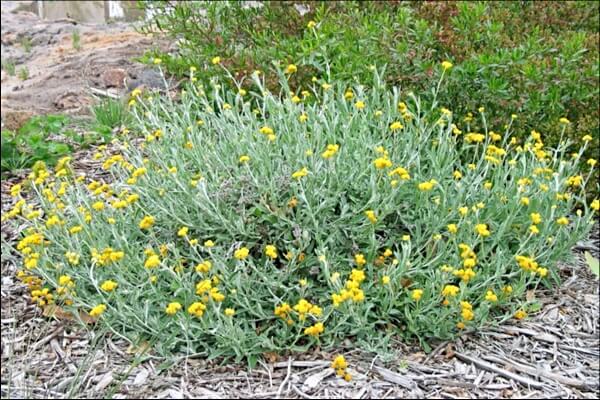
Source: Mountain View Nursery
Yellow buttons, or the everlasting daisy are the common names for this striking native ground cover plant. It spreads well, and will fill out borders, but does occasionally need dividing to maintain its vibrancy.
The upright stems reach around 30cm tall at most, and its soft silvery foliage is a great way to add rhythms to beds and borders.
Most usefully, its dense root system once established is that of dozens of plants, meaning a single plant can be divided into three after a few years, making it one of the most cost-effective ground cover natives in Australia.
26. Snake Vine (Hibbertia scandens)
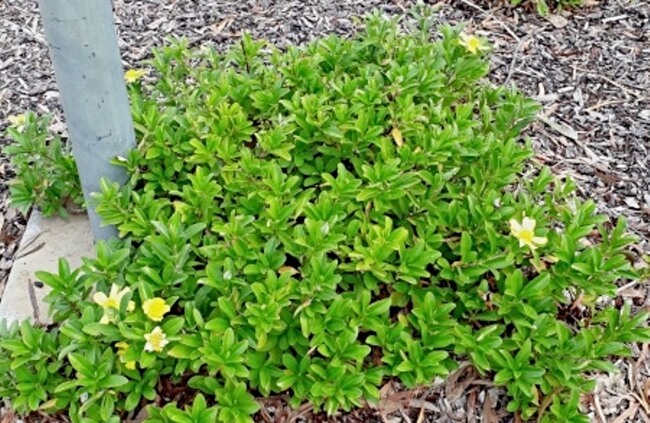
Source: Domus Nursery
Also called the climbing guinea flower, the snake vine, or Hibbertia scandens, is one of the easiest ground cover perennials you can add to a garden.
They like well-drained soil, and don’t need much feeding – though an annual mulch of organic matter around the base of the plant goes a long way to extending the flowering season.
While the yellow flowers are worth celebrating, it’s the waxy foliage that helps to create a formality out of the informal shape of this native ground cover plant, and helps it to provide a base for taller shrubs and trees without taking the spotlight away from more prized flowers.
27. Austral Stork’s-bill (Pelargonium australe)

Source: Castlemaine Flora
Pelargoniums are a personal favourite of mine. They have been for as long as I can recall. Their felted foliage and dramatic flowers, regardless of the species or cultivar you grow, add something really special to a garden.
They have a lightness that nothing else quite matches, and while not as tough as some non-native cranesbill geraniums, Pelargonium australe will really sign in a well-fed border.
They need plenty of liquid feed if you can provide it, and well-drained loamy soils where possible, but these natives are less fussy than other cultivars and they do tend to cope in a wider variety of conditions.
Refer to our guide for more information on growing pelargoniums.
28. Billy Buttons (Pycnosorus globosus)
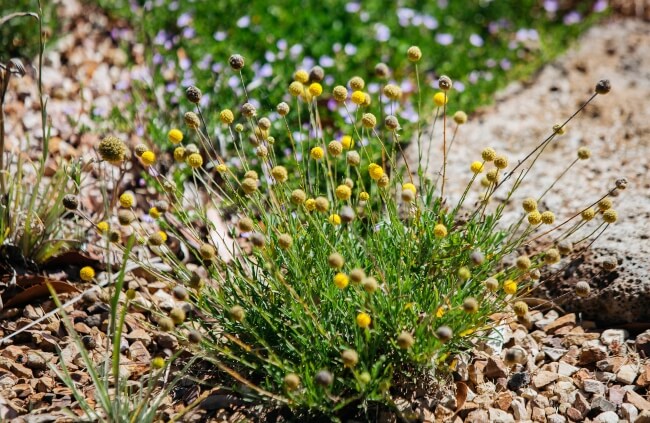
Source: Native Plant Project
Billy buttons, perhaps thanks to its name, has become one of Australia’s most popular native wildflowers and can be seen growing in most cultivated spaces across the country. But, aside from its name, it has earned that popularity through its tightly bound flower heads, and neatly clumping foliage.
When planted in bulk in beds and borders, it creates a dramatic swathe of bright yellow flowers that lasts right through spring and summer, offering seasonal joy in a wonderfully uniform and regimented way that works just as well in formal gardens as wild ones.
Our ultimate grow guide for Billy Buttons tells you everything you need to know about growing this spectacular wildflower.
29. Small-fruit Fan-flower (Scaevola albida)
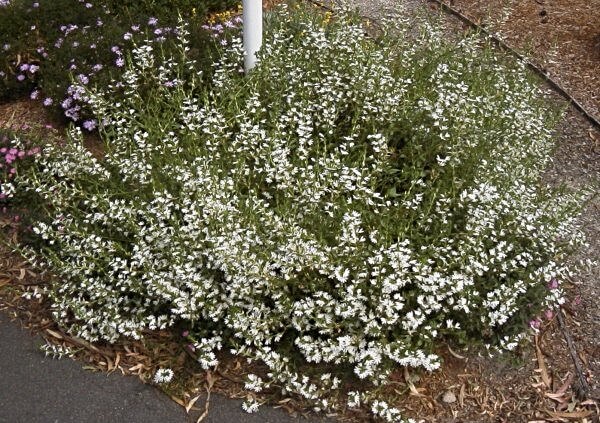
Source: Australian Home Design Directory
Scaevola albida, the small fruit fan-flower or pale fan-flower, is a very particular species of Scaevola (noted above). Its soft off-white flowers stipple its fine foliage, and it has the added benefit of growing more tightly to the ground, in mounds that rarely grow taller than 25cm.
Its usefulness as a native ground cover plant is noted in another common name, and the name of its most popular cultivar, ‘White Carpet’.
Other Ground Cover Plants that Thrive in Australia
30. Bergenia
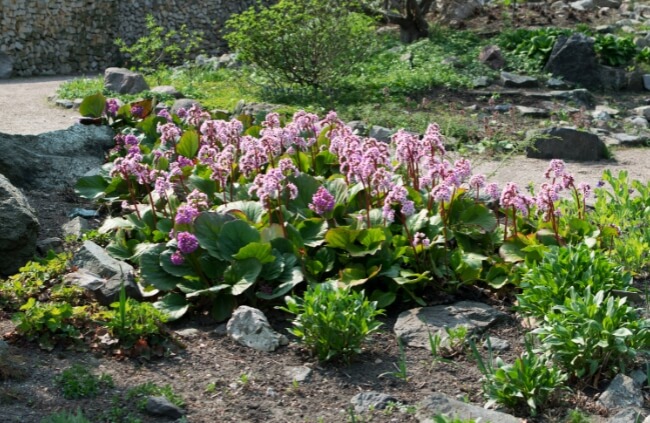
Bergenia are perhaps the lowest maintenance ground cover plants of all. Roughly once every five years, their dead leaves need pulling up from beneath a healthy top layer, and if you don’t like the way their vibrant flowers die back, simply tug them out by hand and they will separate similarly to rhubarb, at their base.
Their large waxy leaves suffer very little from pest damage, and their crawling roots do an excellent job of filling in empty gaps in borders, as well as tying together wider planting schemes, even in shade.
31. Coral Bells (Heuchera)
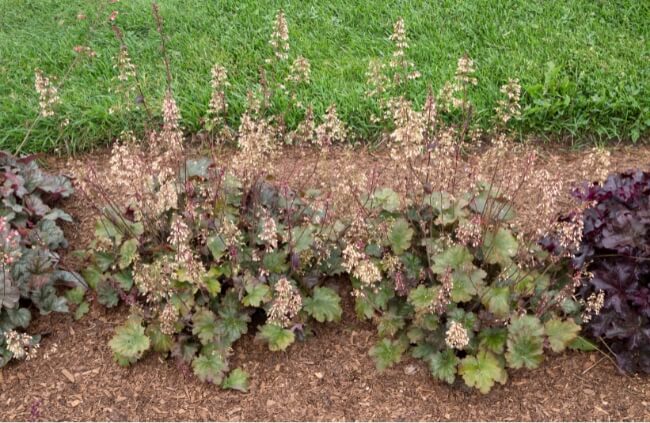
Heuchera are generally happy in any condition. We have a few grouped together next to our pond, and some growing in the gravel border in full sun. Their exquisitely coloured foliage is impossible to define in such a short space, but they come in every shade from bronze to dusty black, and their flowers (each with a varying saturation somewhere between white and crimson) stand tall for most of the summer.
If you want a vibrant, low-maintenance, easy-going ground cover that you can’t kill, try planting heuchera around your borders. One plant can be divided in three after a few years, so they can quickly fill up a garden as ground cover on a budget.
32. Crocus

Crocus are grown around the world as the first sign of spring, and to mark the end of winter. In much of Australia, they flower earlier than this, but their function in gardens is still the same - they cover the ground, smothering any potential early germination from last year’s self-seeded weeds.
While there are a handful that is grown specifically for the production of saffron, most species of crocus can be used to harvest saffron, which is simply the stamens having been harvested as soon as the flowers open, ideally on a warm morning, but if you’d prefer to value their ornamental properties, don’t harvest them, and allow the flowers to die back naturally to feed the bulbs for next year.
More on growing these beautiful early-flowering bulbs can be found in our guide to growing Crocus.
33. Hellebores

Hellebores are often called Christmas roses as they tend to flower around that time of year in their northern hemisphere habitat, but in fertile shaded positions, they can flower straight through winter in any part of Australia.
Traditionally, gardeners picked off the leaves to display flowers to more effect, but to have the best impact as ground cover and any benefit to weed prevention, the foliage should be kept on your hellebores.
Read our guide for information on growing Hellebores.
34. Lavender

Lavender offers scent, structure, and potently relaxing fragrance, but it’s also one of the best ground cover plants for dry, sunny, spots in your garden.
Individual plants can reach 2m across, and 1m tall, but are best pruned annually to restrict growth, with a selection of lavender plants grown alongside each other. This way you’ll get dense flowering and longer-lived ground cover shrubs.
Our guide to growing lavender in Australia offers everything you need to know about planting your own.
35. Nepeta

Nepeta, or catmint, isn’t a ground cover plant to choose lightly. It will almost definitely attract cats to your garden, and in the worst-case scenario, they will eat the entire thing.
Weirdly, catmint effects every cat differently so if you're lucky, you’ll be able to grow this slightly more moisture-tolerant alternative to lavender in your garden, but (as you might be able to tell) I can’t, because my neighbour’s cat is a serious catmint junkie, and has crushed, then chewed, then digested, every catmint we have ever planted.
If you’re willing to take the risk, check out our guide to growing catmint.
36. Snow in Summer (Cerastium tomentosum)

Cerastium tomentosum, or snow in summer, is used to good drainage but does tend to prefer more temperature zones, so while it technically likes full sun, warmer gardens in Australia should aim to offer some midday shade to this generally tough ground-cover plant.
Once established, snow in summer provides delicate swathes of cloudy white flowers over tough silvery foliage that doesn’t mind being walked over.
37. Dichondra

Source: Brookgreen Gardens
Dichondra is a truly fascinating ground cover plant that looks at its very best when allowed to weave in and out of paving. It’s incredibly tough and can be used as a fairly high-traffic lawn alternative too, but perhaps more interestingly is its habit of growing up and over rocks and fences thanks to its relationship to climbing morning glory.
If you’re interested in growing dichondra, read our full Dichondra grow guide.
38. Sedum
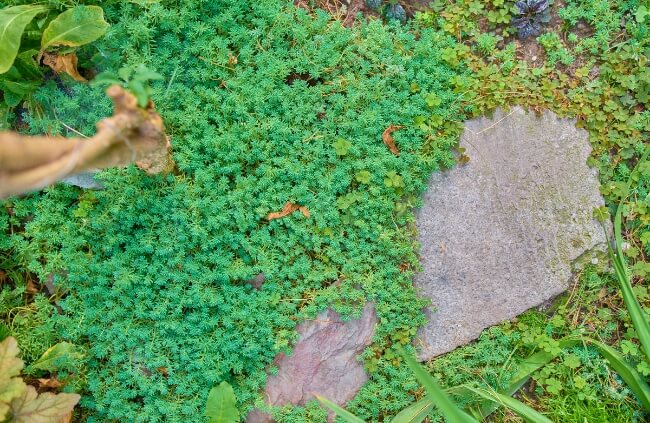
Sedum come in all shapes, colours and sizes, with gentle variegations to foliage, trailing cultivars and upright umbels. They will grow in most conditions but prefer free-draining, gritty soils, and full sun.
In shade, they tend to grow quite flat and hollow out in the centres. For gardens, particularly with formal pathways, sedums make a wonderful edging ground plant.
Learn to grow your own with our guide to growing sedums.
39. Hostas

Hostas like humid, damp, shaded conditions but will grow in full sun provided they are offered good irrigation. They are famously susceptible to slugs while plants are young, but once established, healthy hostas are rarely touched by pests.
If you want to get ahead and grow your own ornamentally shade-loving ground cover plants, Hostas makes a brilliant choice and races ahead following spring planting.
40. Creeping Thyme

There are many varieties of creeping thyme, some that enjoy compacted soils, and others that will grow in cracks between bricks. Whatever situation you’re trying to develop, their dense carpets of flowers are relatively easy to achieve, but slow to develop.
Once established though, ground cover thyme is an exceptionally tough plant that releases buckets of scent when stepped on or brushed against.
More information can be found in our guide to growing ground cover thyme.
41. Nasturtiums

We all go through phases and fashions in gardening, and right now, my biggest obsession is nasturtiums. These old-fashioned cottage garden annuals will self-seed around the garden and come up pretty much everywhere, but the variegated forms seem to be much more controllable than typical cultivars.
If you do grow more old fashioned nasturtiums, aim to grow them away from taller plants and shrubs, or be prepared to prune them regularly. Instead, opt for mound-forming nasturtiums that will form dense domes of foliage and self-managing flowers that keep going for almost eight months of the year.
Grow your own nasturtiums with the help of our nasturtium care guide.
42. Periwinkle (Vinca)
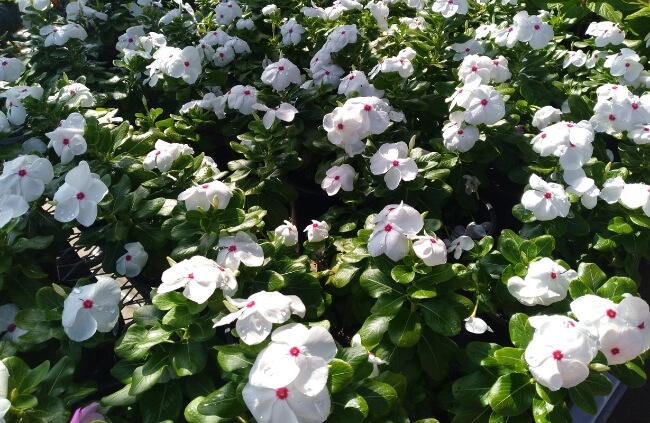
Vinca can be grown as climbing wall cover, or trailing ground cover. Vinca minor is the most popular and will grow anywhere with reasonably good moisture levels even on quite nutrient-poor soils.
It roots from the stem so it will spread quickly around your garden, but the roots are shallow so easy to manage, and their splashes of blue that dot around the border are wonderfully calming - particularly when you stop to consider how effective they’ve been at smothering weeds.
Caring for Different Types of Ground Cover Plants
Every garden is different, and every gardener has a different vision for how they want their plants to perform. So, how you care for your ground cover plants depends on the desired end result.
Perennial ground cover plants
Perennial ground cover plants, like herbaceous Bergenias, often come with a compromise of dull seasons, as they are not always evergreen. Some need cutting back to the base to prevent overwinter fungal problems, and improve their shape, but others should be left to die back naturally
Annual ground cover plants
Annual ground cover comes in so many forms that it’s nearly impossible to offer a guide, but depending on what you’re growing, you will need to re-seed, or encourage self-seeding by removing dead growth, to make sure fallen seeds have good contact with the soil in late summer and autumn.
Prostrate shrubs
Others benefit from gentle pruning, or cloud pruning to make sure they don’t develop hollow centres. Salvia and lavender in particular should be cut back slightly after flowering so they grow freshly from the same point each year.
Ground cover bulbs
If you choose the right bulb for the right place, little ongoing care is needed. Crocus, for example, will come back year after year and spread evenly through borders. Snowdrops too, with some good fortune, and cold winters, will present beautifully in spring.
If you want more ornamental bulbs, like tulips, choose simple varieties that come back for several years, so you don’t need to replace the bulbs every year. And always, always, let the foliage die back naturally when bulbs finish flowering, and it is that that feeds the bulbs for next year’s flowers.
Ground Cover Plants Frequently Asked Questions
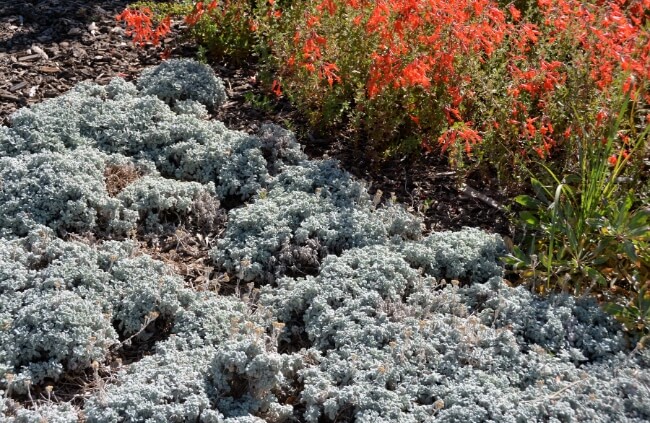
What is the fastest growing ground cover plant?
Aubrietia is a fast growing perennial ground cover, but nothing is faster growing than annual lobelia. You will need to re-sow each year, but with a single tray of plug plants, you can fill entire borders with vibrant colour.
What is the best ground cover for poor soil?
Creeping thyme is a great option for ground cover on poor soil. It thrives in free-draining conditions and doesn’t require much in the way of nutrients, so can cope in most gardens.
What is the easiest flowering ground cover to grow?
Creeping phlox is a reliable ground cover that will come back every year, and double in size each year for the first few years. Phlox offers a carpet of flowering ground cover in a range of colours, but is particularly attractive in pale pink.
What is the fastest growing evergreen ground cover?
Many types of ground cover grevilleas are evergreen, providing fast growing ground cover with beautiful foliage and flowers for any Australian garden.
What is the best ground cover for poor soil?
While it likes more temperate climates than most of Australia can give it, cotoneaster is a great ground cover plant for poor, dry, clay soil, as its hardy roots help to break up poor soils, and its low-growing canopy, while slow to establish, requires little ongoing care.
Wrapping Up Our Guide to Choosing Ground Cover Plants in Australia
Ground cover plants should always be a consideration in any garden design, whether you’re adapting an existing plot, or starting a garden from scratch.
We all have a tendency to build gardens from the top down, starting with tall, flowering shrubs, and working down through vibrant perennials, but those structural, low-growing plants that define our borders are just as important to get right.
Think about the overall impact of your groundcover through the season too, leaving space for bulbs and herbaceous ground cover plants within a base of simple shrubs.
Published on October 13, 2023 by Lorri Hopkins
Last Updated on May 4, 2024





